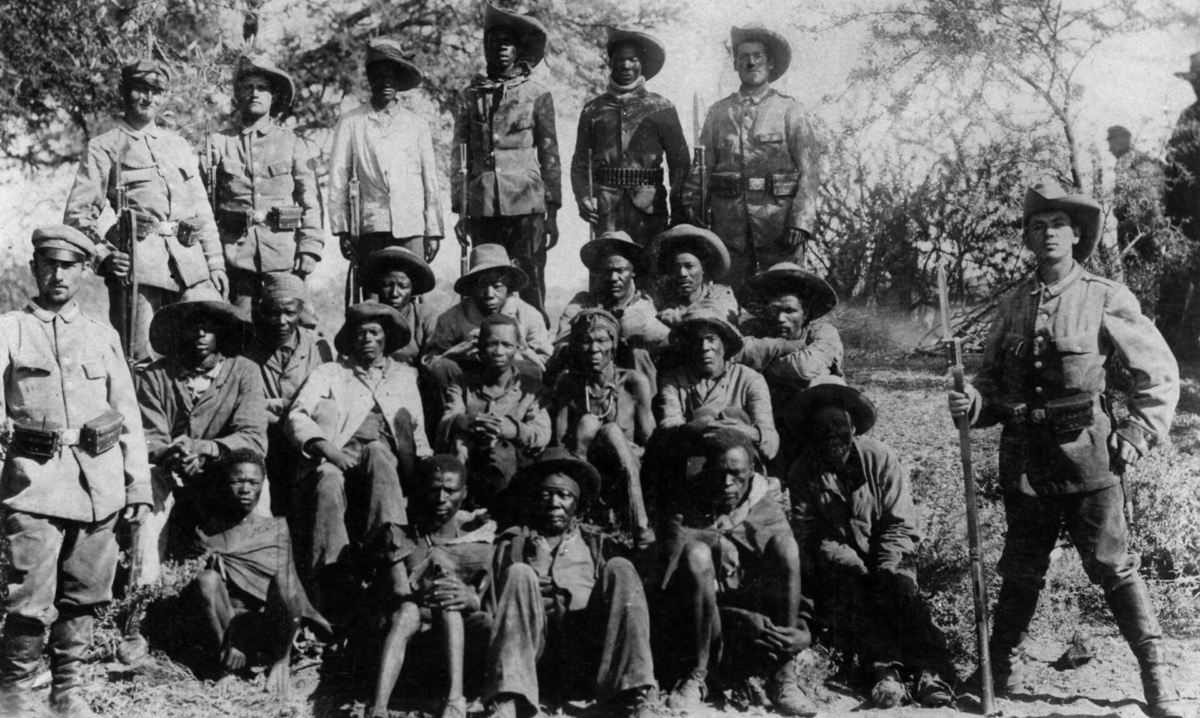Born around 1854, Samuel Maherero emerged as a prominent figure in the history of Namibia, leaving a profound impact on the nation’s socio-political landscape. He was the son of a distinguished Herero chief and an early nationalist leader of Namibia. His life story is a testament to a tribe’s struggle against colonial domination and a beacon of resistance and resilience.
Quick Facts About Chief Samuel Maherero
- Title: Paramount Chief of the Herero Tribe: Samuel Maherero led the Herero people as their paramount chief during a tumultuous period marked by German colonization.
- Resistance Against Colonization: He is best known for his resistance against German imperial forces, notably during the Battle of Waterberg in 1904.
- Exile and Death: After the Herero and Namaqua genocide, Maherero was forced into exile, eventually dying in Botswana in 1923.
- Legacy and Honor: Maherero’s legacy lives on, and in 2007, his remains were repatriated and reburied in Okahandja to honor his memory as a national hero.
- Annual Commemorations: The Herero people celebrate the Red Flag Day every year in Okahandja to remember the resistance and commemorate Maherero’s leadership.
- Portrayal in Arts: His life and resistance are depicted in various forms of art, including plays, documentaries, and books, contributing to the oral history and cultural heritage of Namibia. Read Also: Discovering Namibia: Germany’s Footprint in Africa

The Early Years of Samuel Maherero
Samuel Maherero’s early life was shaped by the rich culture of the Herero people, a pastoral tribe with a complex social hierarchy and a deep-rooted connection to their land. As the son of Chief Maherero Kaipanga, he inherited a legacy of leadership(After his father died in 1890) and an acute awareness of the encroaching threats posed by German colonizers. From a young age, Samuel was immersed in the tribal traditions of governance and warfare, fostering in him the qualities necessary to preserve his people’s autonomy. Read Also: Exploring the African Diversity: A Glimpse into Each Nation
The formative years of Samuel Maherero were also characterized by his exposure to the European missionaries, who were among the first to establish a presence in Namibia. This encounter with Western education and Christianity gave Samuel additional perspectives and skill sets, including literacy and fluency in German, which later played pivotal roles in his dealings with colonial powers. The balance of traditional Herero ways and newfound knowledge from outside influences equipped Samuel with a blend of insight and foresight, rare among his contemporaries, as he approached the defining challenges of his time.
The Struggle for Independence
The defining period of Maherero’s life was his leadership of the Herero people during their revolt against German occupation. The Struggle for Independence for the Herero under Chief Samuel Maherero’s leadership was marked by an escalating series of conflicts and negotiations with German colonizers. Amidst increasing demands on their land and freedom, Maherero initially pursued a diplomacy strategy to safeguard Herero interests through treaties and alliances.
However, German settlers’ consistent encroachments on Herero grazing lands, coupled with racial discrimination and economic exploitation, led to an untenable situation. These pressures culminated in the outbreak of the Herero Wars in 1904, a stark turning point characterized by fierce resistance from the Herero people against German military campaigns. Despite being heavily outgunned and outnumbered, Maherero’s strategic acumen came to the fore during these confrontations.
Yet, after the devastating Battle of Waterberg, with the survival of his people at stake, Maherero led a strategic retreat, guiding a remnant of the Herero into the desert towards British Bechuanaland (modern-day Botswana), seeking asylum from their pursuers. This marked a somber period of exile, during which the dream of Herero independence was deferred but never extinguished.

Leadership Style and Achievements
Samuel Maherero’s leadership was characterized by a blend of traditional authority and innovative strategy, which coalesced to form a responsive and adaptable approach to the challenges of his time. His deep understanding of traditional Herero culture and values made him a unifying figurehead, respected by young and old within the tribe.
As a leader, Maherero was known for his strategic acumen and unwavering commitment to his people’s welfare. He was a pragmatic leader who knew when to resist and when to cooperate with the German colonizers. However, his ultimate goal remained unchanged: liberating Herero lands and preserving his people’s rights and dignity. Throughout his tenure, Maherero demonstrated an exceptional ability to adapt to changing circumstances while maintaining a clear vision for his people’s future.
Maherero’s leadership and achievements can be reflected in the following list:
- Unified Command: Successfully galvanized disparate Herero factions under a unified command to face the German advances.
- Diplomatic Engagement: Engaged in diplomacy with German colonizers, seeking to negotiate for the Herero people’s rights and protections.
- Battlefield Tactics: Employed strategic military tactics against superior German forces, evidenced in battles like the one at Waterberg.
- Management of Alliances: Managed shifting alliances with neighboring tribes and colonial powers, including attempting alliances with the British in Bechuanaland.
- Cultural Preservation: Worked towards preserving Herero culture and society through the tumult of colonial invasion and the subsequent genocide.
- Humanitarian Efforts: Organized the exodus of his people into the Kalahari Desert, which, despite immense hardships, resulted in the survival of many Herero.
- Resistance Symbol: Became a symbol of resistance and a source of unity and identity for the Herero people during and after the German occupation.
- Legacy of Independence: Although in exile, he continued to advocate for Herero rights and independence, a legacy that inspired future generations in Namibia’s struggle for freedom.
Legacy and Impact
Despite his death in 1923, Samuel Maherero’s legacy lives on, not only in Namibia but also as a potent symbol of resistance and resilience in the face of colonialism. His efforts laid the groundwork for later movements towards Namibian independence, which was eventually realized in 1990. Today, Maherero is honored annually during the Maherero Day celebrations, where Herero people dress in traditional attire and gather at his memorial in Okahandja to pay homage to his memory and what he stood for.
Moreover, historians and political leaders continue to study his strategic approach to leadership and his unwavering dedication to his people’s sovereignty, serving as an inspiration for indigenous resistance strategies worldwide. The narrative of Maherero’s life and his staunch opposition to German occupation endures through oral histories, keeping the spirit of the Herero culture vibrantly alive for future generations.
Bottom Line
Samuel Maherero’s life and legacy embody the indomitable spirit of the Herero people, who fought for their land, culture, and freedom. His journey from a traditional leader to a symbol of resistance against colonial oppression is an enduring example of leadership, courage, and determination in the face of overwhelming odds. Today, Samuel Maherero remains an iconic figure in Namibian history, a testament to the strength and resilience of indigenous peoples worldwide.



